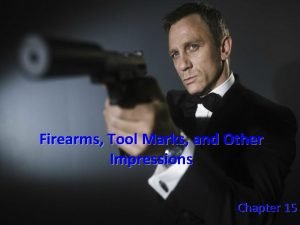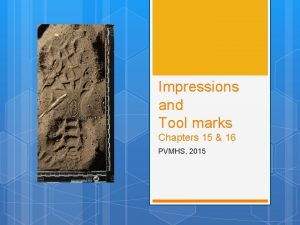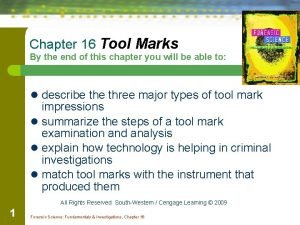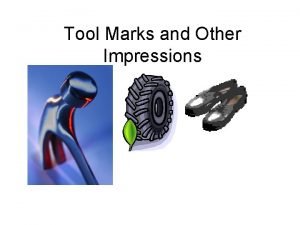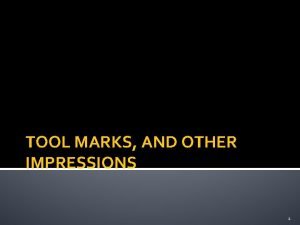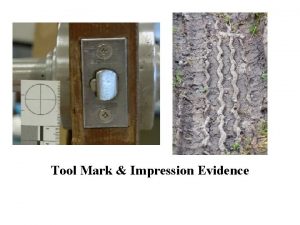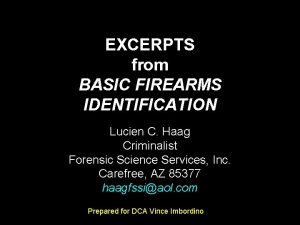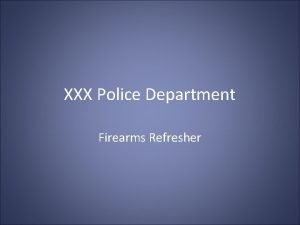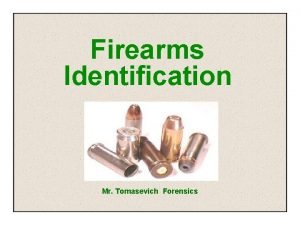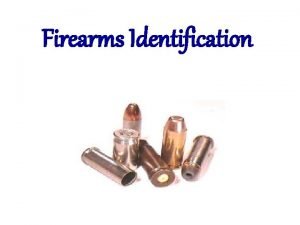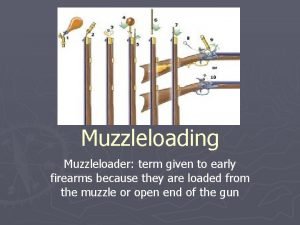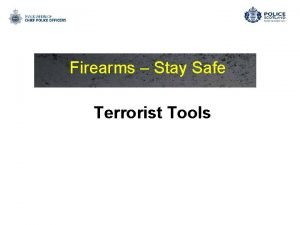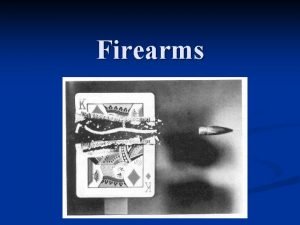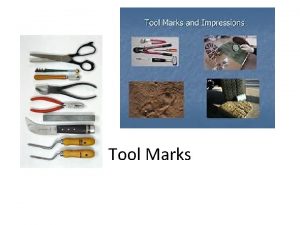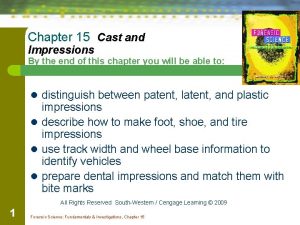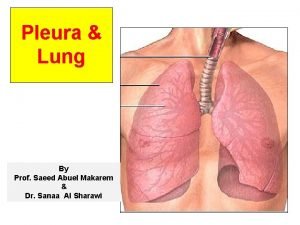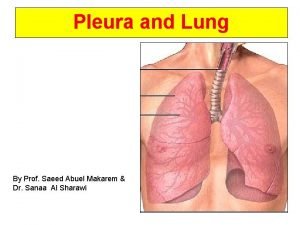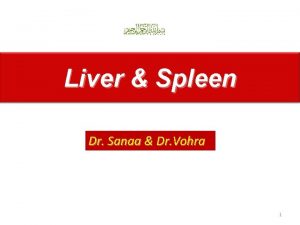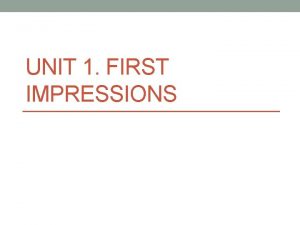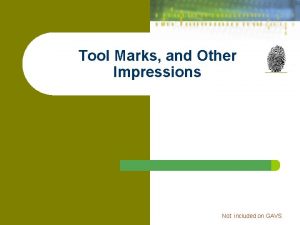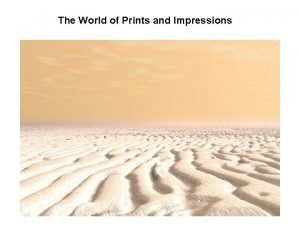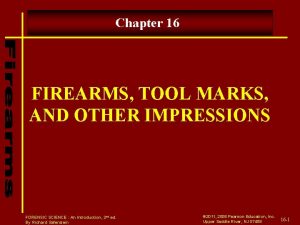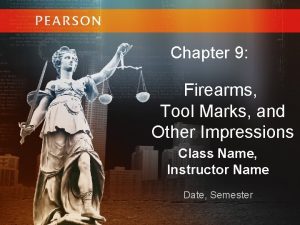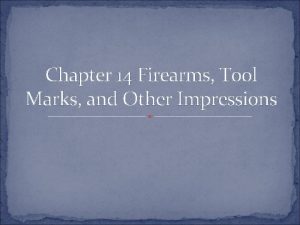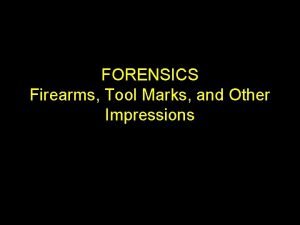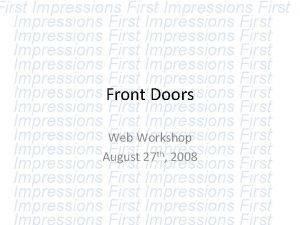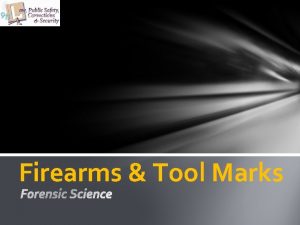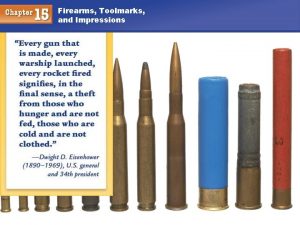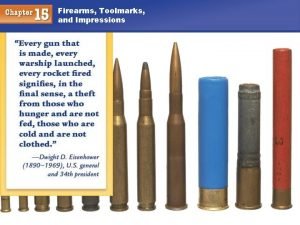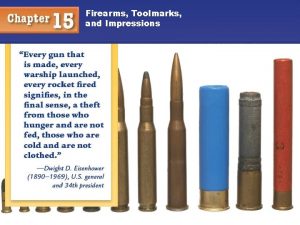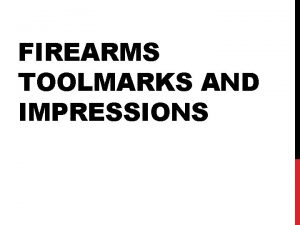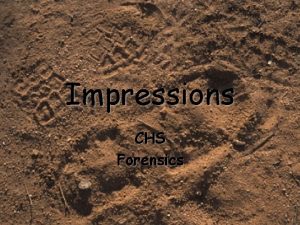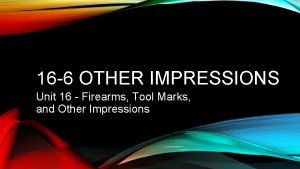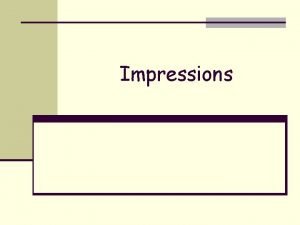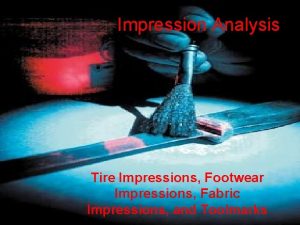Firearms Tool Marks and Other Impressions Chapter 15




















































- Slides: 52

Firearms, Tool Marks, and Other Impressions Chapter 15

Introduction • Just like variations in fingerprint minutiae, can lead to the identification of humans, structural variations in tools, guns, bullets, etc. can lead to the identification of a weapon or a tool used to commit a crime. • Because crime scenes involving shootings are high in occurrence, the science of Firearms Identification or Forensic Ballistics has developed.

Firearm Identification One can determine the following with the help of forensic ballistics: 1. 2. 3. 4. Type of bullet Type of firearm Serial number on weapon (even if it is sanded off) Gunshot residue (GSR) patterns on hands, clothes, wounds 5. The estimation of muzzle-to-target distances

Ballistics - definition • Ballistics, (Greek: ba'llein) to “throw” It is the science of the mechanics of motion, and the effects of projectiles like bullets on targets.

First, a little history lesson. Wham! Bam! Thank you, Ming. • The invention of gunpowder led to the development of firearms. • Gunpowder first appeared in use in China over a thousand years ago, but was used primarily in firecrackers and only sparingly in weapons for military use (canons and such) • The knowledge of gunpowder manufacture spread to Europe in the 14 th century did not at first lead to military usage. • Once they realized how much damage a projectile can do to a knight’s armor or a fortification, the use of firearms proliferated rapidly.


Gunpowder (Black Powder) • Gunpowder, made of a mixture of – sulfur, – charcoal, and – saltpeter (potassium nitrite) • Its explosive force is due to the fact that 1 mole of solid powder will, when ignited, produce 6 moles of gas. • This rapid expansion in the enclosed space of a metal tube could be used to drive a projectile at high speed in a specified direction. • Modern gunpowder is a more refined version of the primitive gun powder • In modern gun powder, the chemical composition has been altered to provide the greatest expansion with the smallest quantity of gun powder and the least amount of residue.

Guns work much like cannons • A cannon is just a metal tube with a closed rear end an open front end called the bore. The closed end has a small fuse hole. To load the cannon, you pour in gunpowder and then drop in a cannonball. The gunpowder and cannonball sit in the breech, the rear part of the bore. To fire the cannon, you light the fuse. The flame travels along the fuse and finally reaches the gunpowder. • When you ignite gunpowder, it burns rapidly, producing a lot of hot gas in the process. The hot gas applies much greater pressure on the powder side of the cannonball and propels the cannonball out of the cannon at high speed.

Basic List of Firearms 1. Handgun (pistol) 2. Revolver 3. Semiautomatic pistol 4. Rifle (Long gun) 5. Shotgun (Long gun)

Simple, handheld guns (pistols) • The first handheld guns were essentially miniature cannons: – you loaded some gunpowder and – a steel ball and – lit a fuse. • Eventually, this technology gave way to triggeractivated weapons, – such as the flintlock gun (spark created by the force) – the percussion cap (uses an explosive chemical contained in a cap to create the spark).

Basic Handgun Frame

The Evolution of the Bullet Cartridge • The next major innovation in the history of firearms was the bullet cartridge. • Simply put, cartridges are a combination of – a projectile (the bullet), – a propellant (gunpowder, for example) and – a primer (the explosive cap), all contained in one metal package.

Anatomy of a Bullet Cartridge Bullets are used by rifles and handguns Jacket Shotguns use shells

Components of a Bullet Cartridge • Bullet –the projectile that is loaded into a cartridge and fired from a firearm. • Cartridge –This is a self-contained unit that includes an outer casing, projectile (bullet), propellant (gunpowder), and primer (source of ignition). Only the projectile is fired from the gun. The remainder of the spent cartridge is ejected from the weapon. • • Cartridge casing –usually made of brass, steel and aluminum. Better quality cases can be reloaded and reused. Primer – The primer fits into the butt of the cartridge casing or shotgun shell. It contains an explosive chemical. When the trigger is pulled on a firearm, a firing pin is slammed into the primer. This collision causes the primer to explode and ignite the gunpowder. A primer is a small copper or brass cup, containing a precise amount of stable but shock-sensitive explosive mixture, with ingredients such as lead azide or potassium perchlorate. • Jacket – The metal covering over a bullet that overlies a core of different consistency. Jackets are used to manipulate the degree of deformation that occurs upon impact.

More about bullets • Bullets come in many shapes and sizes • They are made of either soft metals like lead or hard ones like bronze. • They can be – hard if they are solid, – or soft, if they have a hollowed tip (hollow-point or hollow-tip. • They are either partially or completely covered by a jacket – usually made of copper. (Hence the phrase “Full Metal Jacket”)

Solid Bullets • Made of bronze, copper -nickel alloys

Soft-point Bullet a. k. a soft-nose bullet A soft-point bullet, also known as a softnosed bullet, is a lead bullet with a copper or brass jacket that is left open at the tip, exposing some of the lead inside.

Hollow-point bullets a. k. a. hollow-nose • Contain a hollow in the tip Soft-point hollow nose • Hollow-tip bullets are designed to “mushroom” upon impact - to cause more tissue damage – used for hunting. • They can be partially jacketed (soft-point) or fully jacketed • If they are partially jacket, they are called soft-point hollow nose bullets Full metal jacket hollow nose

Rim-fire vs. Center-fire Cartridges Center-fire cartridges are usually more powerful than rim-fire ones.

Shotgun Shells The “bullet” part of the shotgun shell can either be tiny pellets or “shell” that spray out or a single “slug”. (Wad)

Rifle vs. Shotgun • Rifles: A gets its name from the presence of spiral grooves in the bore called "rifling. " These grooves spin the bullet, thereby increasing the rifle's range and accuracy. – – Grooved Bore Single Projectile Long Range Front & Rear Sights • Shotguns: – – Smooth Bore Multiple Projectiles Short Range Front Sight Only These differences determine the specific uses of each of these firearms. Rifles are designed for accuracy to hit a precise point. Shotguns are designed to shoot a spread of shot at moving targets.

What is a Caliber? • The inside diameter of the barrel of a firearm is called the caliber • The word caliber is used to differentiate bullets according to their diameter and guns by the bullet size they fire. • The final number is represented as 1/100 th of the actual diameter (inches) • So if the diameter is. 32 inches, it is a. 32 caliber bullet. The decimal point is generally dropped when spoken, making it “thirty-two caliber". • In Europe, they use metric, so come bullet calibers are expressed as mm for example, 9 mm bullet.

What is “Magnum”? • A cartridge that earns the “magnum” title, has more power or charge than another cartridge of the same caliber.

Is Bigger Better? 9 mm soft point bullets

How Guns Fire 1. 2. 3. 4. 5. 6. 7. 8. The cartridge goes into chamber Cartridge in chamber Firing pin forcefully strikes primer Primer explodes, ignites powder Gas from burning powder expands in cartridge Gas pushes bullet out with force Speeding bullet exits barrel Bullet and escaping gases make the "BANG”

Manual, Semi-automatic and Automatic • In manual guns, the user must insert a round into the chamber, either manually or through the action of the weapon (e. g. levers, pumps, etc), between shots. • In semi-automatics, a trigger pull is needed per round fired. For example, to fire ten rounds in a semi -automatic firearm, the trigger would need to be pulled ten times (once for each round fired) • In contrast, a fully automatic firearm, can continue to fire as long as the trigger is held pulled or until it runs out of ammunition.


1. Comparison of Rifling Marks • No two rifled barrels are alike • Even made one after another, by the same manufacturer, the rifling process can never be identical

Rifling and Bullets • As the bullet is expelled through a barrel, the rifling causes it to spin • The rifling also leaves impressions on the surface of the bullet • These indentations on the bullet can help identify the firearm used.

• The bullet on the left was fired from an automatic pistol, and the rifling grooves are the same distance apart from top to bottom. The bullet on the right was fired from a revolver, and the grooves are wider at the top then at the bottom, due to slippage.


2. Comparison of Firing Pin Indentations • Examination of some ballistic characteristics can be done with the naked eye. Cartridge on the left was fired from a "Glock" automatic pistol, as for the on the right, it could have been fired from many different guns, and closer examination is required.


Two cartridges with the same firing pin imprint – positive I. D.

Firing Pin Drag Marks

3. Casing Extraction and Ejection Marks Used cartridge casings are first removed from the chamber by extractor mechanisms. The casings are then dragged across the edge of the ejection port as they are ejected from the weapon. These extractor and ejector marks can be matched.

Action/Pressure marks on Cartridge • When the bullet is fired a large increase in pressure is experienced in the cartridge case thereby pressing it into the walls of the chamber. This pressing into the chamber walls is what creates the pattern on the cartridge case.

Breechblock Markings • The breechblock is the back of the gun barrel. • A bullet leaves its cartridge with such force, that it pushes the empty cartridge back against the barrel’s breechblock. • This leaves a distinctive pattern on the back of the cartridge. • These markings can be compared to match guns


4. Expansion Physics • One can observe the damage done by a projectile and determine the type it was (if it is not found) • This is a 30 caliber soft-point bullet that mushroomed and probably caused more damage than just a hole the width of the original bullet.


IBIS and NIBIN • Integrated Ballistic Identification System – Developed for the Beaureau of Alcohol, Tobacco, Firearms, and Explosives (ATF) – Uses several computer programs to help identify firearms • In 1999, the FBI and ATF consolidated their resources and came up with the NIBIN (National Integrated Ballistics Identification Network)

Gun Powder Residues and the Stories that they tell 1. When a gun id fired, some black powder remains unburned. – Some of this unburned powder, burned powder and smoke from the burned powder is propelled out of the barrel along with the bullet, toward the target. – These are deposited in the target, along with the bullet – This will help determine the firing distance

Distance Determination 38 caliber at 12 inches The greater the distance from the target, the farther the GSR will spread.

Contact Shots • In contact gunshots a halo of lead vapor or smoke is left around the hole or in this case the wound. • Contact halos are found around holes in targets that were at a distance of 12 to 18 inches or less

Bullet Wipe • A bullet wipe residue is a darkened ring around the immediate margins of the hole. • Bullet wipe is found around holes in targets farther than 3 feet. • This ring of residue is caused by lead being wiped from the surface of the bullet as it passes through the material. • Lead bullets normally leave the heaviest deposits of bullet wipe residue but it is not unusual for jacketed bullets to also deposit bullet wipe residue. Lead and primer residues in the barrel can be on the surface of a jacketed bullet

Greiss Test • A test conducted on or around bullet holes to pick up residues of unspent gun powder. • Nitrites are a found in incompletely burned powder (Nitrocellulose is found in modern smokeless powders and nitrites are the “leftovers”) • When the Greiss reagent is added to a nitritecontaining sample, it turns pink.

Positive Greiss Test

GSR on The Shooter • The mix of spent powder, unspent powder and lead vapor/smoke is also propelled toward the shooter. • On can use various tests to determine if – The individual fired the gun – The individual handled the gun

Serial Number Restoration • Many manufactured items such as engines and firearms have serial numbers stamped into their metal components. • These stamps use hard steel dyes that sink into the metal up to a certain depth. • Sometimes these numbers are removed by grinding, rifling, etc. • When one applies an etching agent to the surface where the serial number used to be, the area that used to contain the hard steel dye numbers will dissolve away faster, because the stamped region was more “fatigued”. • However, if the removal was complete and there is no more fatigued area left, the number cannot be restored.

Shoeprint and Tire Tread Casting

THE END
 Slide drag mark
Slide drag mark Chapter 15 firearms toolmarks and impressions
Chapter 15 firearms toolmarks and impressions Indentation tool marks
Indentation tool marks How is tool mark impression evidence examined
How is tool mark impression evidence examined A wear pattern cut gouge
A wear pattern cut gouge Shoe and tire marks impressed
Shoe and tire marks impressed When to use a exclamation mark
When to use a exclamation mark Patent impressions are
Patent impressions are Mptc firearms instructor manual
Mptc firearms instructor manual Firearms
Firearms Virginia form sp-65
Virginia form sp-65 Xxxpolice
Xxxpolice What is a rifling impression
What is a rifling impression Anatomy of bullet
Anatomy of bullet Firearms
Firearms Firearms
Firearms Firearms
Firearms Drugfire
Drugfire Firearms
Firearms Cdc firearms
Cdc firearms Impressed marks
Impressed marks Race determination from teeth
Race determination from teeth Evidence of evolution of remnants and impressions *
Evidence of evolution of remnants and impressions * There are two basic types of impressions patent and latent
There are two basic types of impressions patent and latent Other initiated self repair example
Other initiated self repair example Potter's tool is data cleaning tool
Potter's tool is data cleaning tool Impression vocabulary
Impression vocabulary Activity 1 dominant impression
Activity 1 dominant impression Mes impressions sur le stage exemple
Mes impressions sur le stage exemple Aortic impression lung
Aortic impression lung Blood supply to pleura
Blood supply to pleura Bracnhes of aorta
Bracnhes of aorta Nerve supply of spleen
Nerve supply of spleen Diaphragmatic surface of the liver
Diaphragmatic surface of the liver Class characteristics of footwear impressions
Class characteristics of footwear impressions Dental impressions course
Dental impressions course Which creates shadows for photographing impression evidence
Which creates shadows for photographing impression evidence Mes impressions sur le stage exemple
Mes impressions sur le stage exemple First impressions examples
First impressions examples 1. describe xpresso lube's service package
1. describe xpresso lube's service package First impression paragraph
First impression paragraph True maps false impressions
True maps false impressions 4.05 quiz footwear and tire marks
4.05 quiz footwear and tire marks Literacy narrative essay examples
Literacy narrative essay examples Arch
Arch Are impressions left by friction ridge skin on a surface
Are impressions left by friction ridge skin on a surface 1st impressions clothing
1st impressions clothing What are your first impressions of beowulf
What are your first impressions of beowulf What are your first impressions of beowulf
What are your first impressions of beowulf Examples of dominant impressions
Examples of dominant impressions First impressions count reading answers
First impressions count reading answers Reading impressions
Reading impressions First impressions finger print
First impressions finger print
